What the Best HVAC SEO Campaigns All Have in Common
It’s no secret, SEO (short for search engine optimization) is a highly effective marketing strategy for HVAC companies.
But you probably already knew that. You’re reading this blog, after all.
What you don’t know are the specific tactics that every successful HVAC SEO campaign has in common—the four pillars of SEO. They are:
- Website Code and Structure
- On-Site Content
- Local SEO
- Off-Site Authority
Each of these pillars plays a unique role in your website’s presence on Google, and ultimately, whether or not your company is found at the top of search results or beat out by the competition. Each pillar works alongside the others to optimize your website’s SEO value for more than 200 of Google’s ranking factors in its algorithm.
In this blog, you’ll learn:
- What the 4 pillars of HVAC SEO are
- Why each pillar is important
- Strategies and tactics to improve the value of each pillar (and rank higher on Google because of it)
Let’s dive in.
Pillar #1 – Website Code and Structure
Website code and structure are the foundation of every successful SEO campaign. HVAC websites that rank at the top of Google are coded and built so search engines can easily find, crawl, and rank your site. This means your website must be:
- Mobile-friendly – In today’s digital age, your website MUST be mobile-friendly. Is it easily navigated without needing to pinch to zoom or scroll sideways? Mobile-friendliness has been a ranking factor in Google’s algorithm since April 21, 2015, and more than half of worldwide web traffic is from mobile devices.
- Fast to load – If your website is slower than a turtle stuck in honey, users will leave it and move on to your competitors. Google has stated that 53% of mobile website visitors will abandon a webpage if it doesn’t load within three seconds. Additionally, websites that load within five seconds earn a 25% higher ad viewability, 70% longer average user sessions, and a 35% lower bounce rate.
- Easy to use – Can users find what they’re looking for, or do they get frustrated because they’re not sure if you can help them? Pull up your website on your own phone and put yourself in the shoes of a potential customer to answer this question.
3 Tips to Optimize Your HVAC Website’s Code and Structure
1. Design with a Mobile-First Mindset On a Responsive Framework
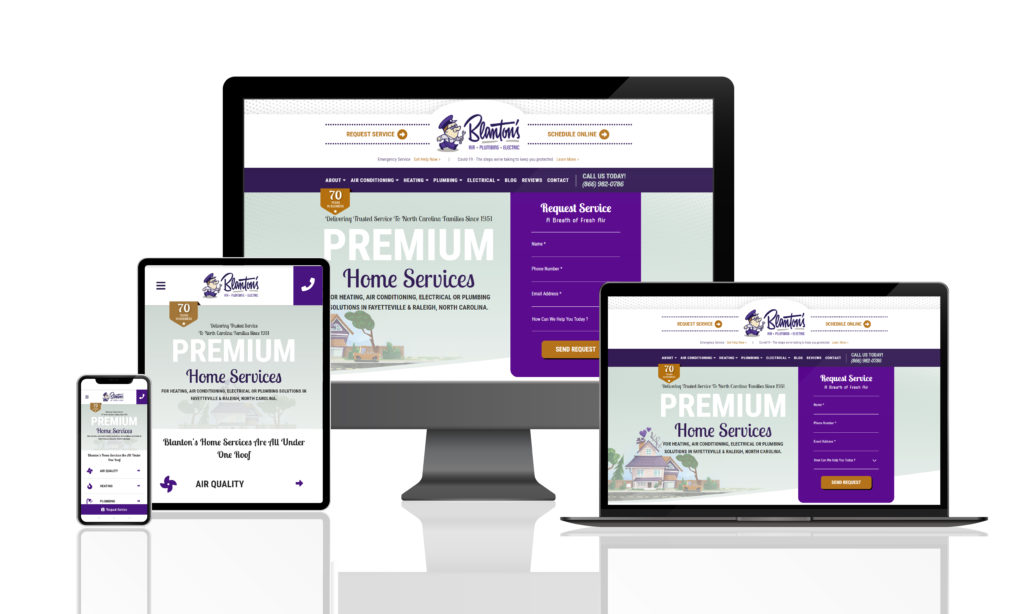
Websites optimized for mobile search come in different shapes and sizes. Most importantly, mobile-optimized websites provide a consistent user experience no matter what device a visitor is viewing it on—a smartphone, tablet, laptop, or desktop computer.
A responsive framework means your HVAC website automatically resizes to match the experience of the user.
Homeowners visiting your site on an iPhone? No problem, your website will respond to the device and render its mobile version.
Homeowner visiting your site on an iPad or tablet? The same thing, your site will render a tablet-ready version.
Laptop or desktop computer? You get the idea…
2. Knock Core Web Vitals Out of the Park
Core Web Vitals are Google’s new way of measuring page speed and user experience on your website. It’s page speed on steroids—and you can read all about Core Web Vitals here.
There are three aspects of Core Web Vitals your HVAC website needs to knock out of the park.

- Loading (Largest Contentful Paint/LCP) – Measures (in seconds) how fast the largest visual element on your page takes to load. For example, a banner image, video, contact form, etc.)
- Interactivity (First Input Delay/FID) – Measures (in milliseconds) how quickly users can interact with your HVAC website. For example, when can they start scrolling, clicking, etc.
- Visual Stability (Cumulative Layout Shift/CLS) – Measures the amount of visual change to your web page after a user starts interacting with it. There is no specific unit of measurement, only a score determined by Google.

3. Make Your Website Easy to Use
Here’s a simple test to determine if your website is easy to use or not. Put yourselves in a customer’s shoes and go visit your website.
Done? Great.
Now, as you browse your website, ask yourself these four questions:
- Does my company provide the service someone needing HVAC service needs? – Make your primary services clearly visible. For most HVAC companies, this includes the obvious like heating and air conditioning and may include services like indoor air quality, duct cleaning, and geothermal.
- Does my website highlight my service areas? – Provide a map of your service area on your website’s homepage. Also, provide a thorough list in the footer of your site.
- How can customers contact my company? – Include web forms on every page, your phone number in the top-right of your website’s navigation, and invest in a website chat service to make it easy for customers to contact you.
- Why should customers choose my company over the competition? – Highlight your company’s differentiators clearly. These may include things your competition doesn’t offer (e.g. 24/7 emergency service), customer reviews, and images of your team.
Pillar #2: On-Site Content
Service Pages Increase Local, Qualified Website Traffic
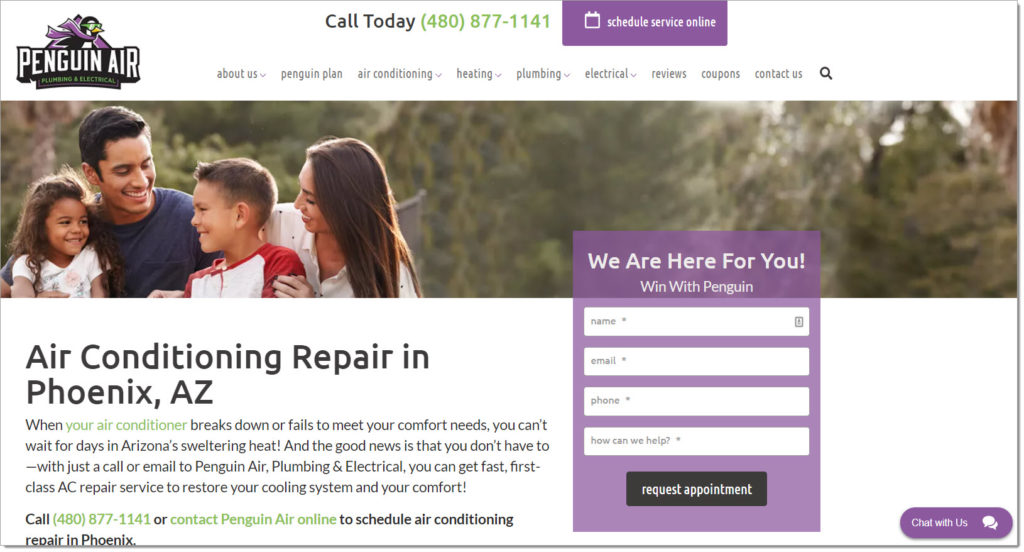
Did you know that Google ranks web pages, not websites? As part of maximizing your online real estate, you need to have pages for all of your lines of business and more specific pages related to those services. For example, service pages targeting highly searched keywords like:
- Air conditioning repair
- Air conditioning installation/replacement
- Air conditioning tune-ups
- Furnace repair
- Heat pump installation
Service pages aren’t the only type of content website visitors like to consume. And the same applies to search engines.
To maximize your online real estate, consider adding the following types of content to your website:
- Blogs
- Images and videos
- Reviews
Do Blogs Provide Value to My HVAC SEO Campaign?
Blogs are a proven HVAC SEO strategy to increase your website’s online visibility. While service pages help your company rank for local, qualified searches like furnace repair near me, blogs can generate thousands of website visits by targeting relevant, yet potentially non-local traffic.
For example, a blog titled Why Choose a Whole-House Humidifier? fits perfectly into an HVAC marketing plan, targeting consumers who are on the fence about adding some moisture into their dry home.
Not only that, blogs are a proven way to generate high-quality backlinks to your website, which in turn help you rank better in search results.
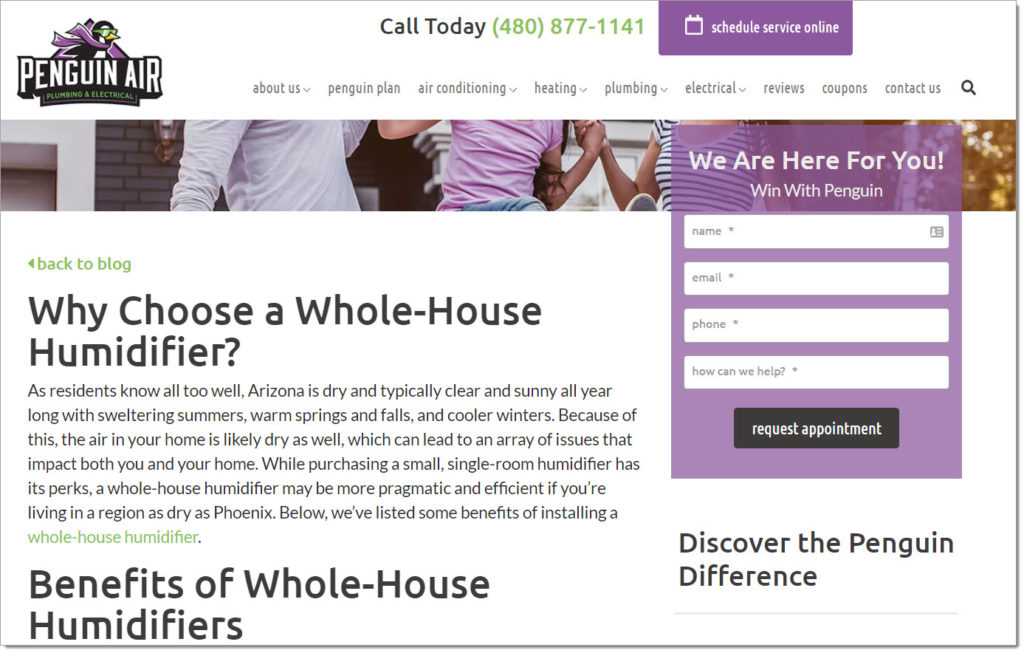
Pillar #3: Local SEO
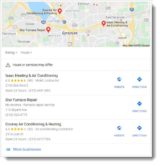 Local SEO services for HVAC companies help your company rank better for localized searches on the web. It also increases your company’s visibility in Google’s local pack (AKA maps listings), as seen in the screenshot on the right.
Local SEO services for HVAC companies help your company rank better for localized searches on the web. It also increases your company’s visibility in Google’s local pack (AKA maps listings), as seen in the screenshot on the right.
- Drives more traffic to your website from the local pack
- Helps mobile users more easily find and access your company’s website
- Ensure your business is found on Google Maps and other navigational apps
- Increases leads and sales from customers with local search intent
3 Local SEO Tips to Boost Search Rankings & Clicks
1. Optimize Your Google My Business Listing
After claiming and verifying your Google My Business (GMB) listing, you’ll want to completely fill in the available fields that Google requires on your Google My Business (GMB) listing. These include adding your company’s:
- NAP info (name, address, phone number)
- About section
- Photos
- Primary business category
- Business hours
- Service areas
- Appointment link (or link to a contact page)
- Health and safety requirements/updates
- Offers
- Amenities
The information you provide to Google via Google My Business feeds the information displayed in the local pack, so it’s critical to show your GMB profile some love and regularly review (and optimize) its content.
*Never add false information to your GMB listing or try to game Google’s system through keyword stuffing. It may result in a Google My Business suspension!
2. Build & Verify Local Directory Listings
Like Google My Business, local directories and the completeness (or lack thereof) also impact your rankings on Google. Other places on the web that HVAC customers go to look for businesses like yours include:
- Nextdoor
- Better Business Bureau (BBB)
- HomeAdvisor
- Angi (formerly Angie’s List)
- Yelp
- Bing Places
And also like Google My Business, you’ll want to claim, verify, and optimize these listings to enhance your local SEO value and rank higher on search results.
3. Get More Reviews
 Did you know that 93% of consumers say online reviews have an impact on their purchase decision?
Did you know that 93% of consumers say online reviews have an impact on their purchase decision?
Not only that, another 58% say they look at online reviews at least weekly, while another 68% are willing to pay up to 15% more for the same service if assured they’ll have a better service.
Review ratings are also the biggest driver of clicks in local search results, and reviews directly affect local SEO rankings.
YES, search engines, including Google, factor in your online reviews (including both quality and quantity) when calculating your search rankings. A search engine’s goal is to help its users (your customers) find the right heating and air conditioning company as quickly as possible.
Reviews help separate the good HVAC companies from the bad, and as shown above, can have a direct impact on whether or not local customers click through to your website or the competition.
We recommend starting on Google My Business. Get as many reviews as you can there, first, since your GMB listing powers both local pack and impacts the performance of your HVAC SEO campaigns.
Pillar #4: Off-Site Authority
Lastly, the best HVAC search engine optimization campaigns don’t just focus on on-site optimizations, they also strategically include off-site SEO, or as we like to call it, improving your off-site authority.
Off-site SEO refers to actions taken outside of your own website to impact your rankings within search engine results pages (SERPs). It builds your website’s authority and provides signals to Google that your company is credible and trustworthy.
Off-site SEO can also carry more than 50% of the ranking factor weight when determining your ranking positions in Google’s organic rankings:
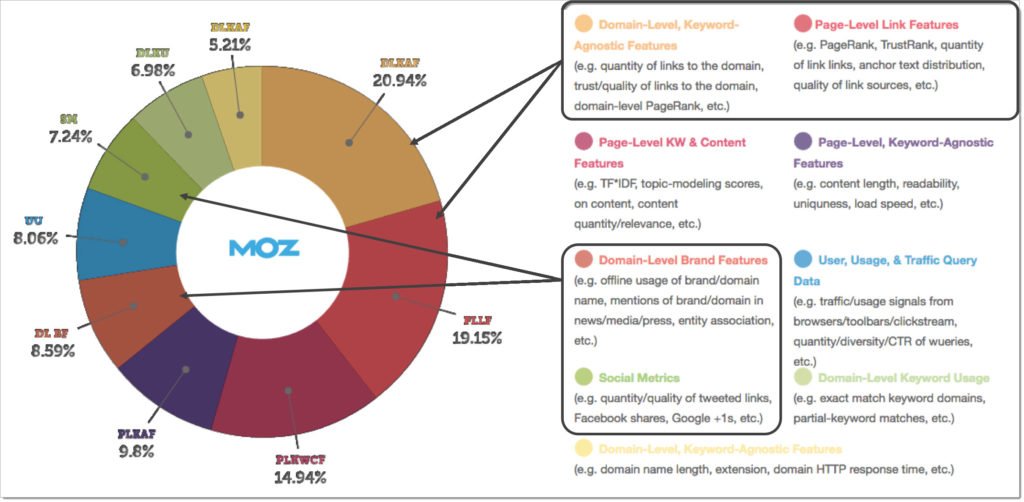 Source: Moz
Source: Moz
How to Improve Your Off-Site Authority in Your HVAC SEO Campaign
1. Build High-Quality, Local Backlinks
Link building is a foundational off-site tactic of HVAC SEO services. Link building is the process of earning links from third-party websites to send users back to yours. HVAC websites with a robust profile of high-quality backlinks rank better on local search results than other HVAC companies with fewer or spammy backlinks.
There are three types of backlinks:
- Natural backlinks – Given editorially without any outreach by the business or the HVAC digital marketing company needed. For example, when a manufacturer links to your blog discussing the cost savings of a new air conditioner.
- Manual backlinks – Unlike natural backlinks, manual backlinks are earned through manual efforts—you or your SEO partner directly reaching out to third-party websites and requesting a backlink to relevant content on your own site.
- Self-created backlinks – Links built on third-party websites that you have a direct influence over. For example, adding a link to your website on your business’ Yelp profile.
2. Don’t Neglect Social Media
Contrary to popular belief, social media affects SEO.
The relationship between social media and SEO is like an alley-oop in basketball. Social media lobs the ball while SEO dunks it.
Although social media signals don’t have a direct impact on search rankings, they affect your off-site SEO in four unique ways:
- Increased authority and brand recognition
- Increased online visibility and traffic to your website
- Broader content distribution and longer content lifespan
- Improved local SEO
Not only that, but Google My Business also pulls in your company’s reviews from Facebook and other directory sites.
Wrapping It Up: The 4 Pillars of Successful HVAC SEO Campaigns
The best HVAC SEO campaigns all have one thing in common. They each prioritize and optimize the four pillars of SEO to create a healthy marketing strategy that increases leads, creates more booked appointments, and ultimately, results in growing revenue.
At Blue Corona, we believe in growing businesses. We work with hundreds of HVAC contractors across the United States, working with them to measurably improve their marketing performance.
Grow Your Business with HVAC SEO Services
Looking to increase leads, reduce your marketing costs, and differentiate your brand online? Contact us today to learn more about how our HVAC SEO services can help you achieve your goals.


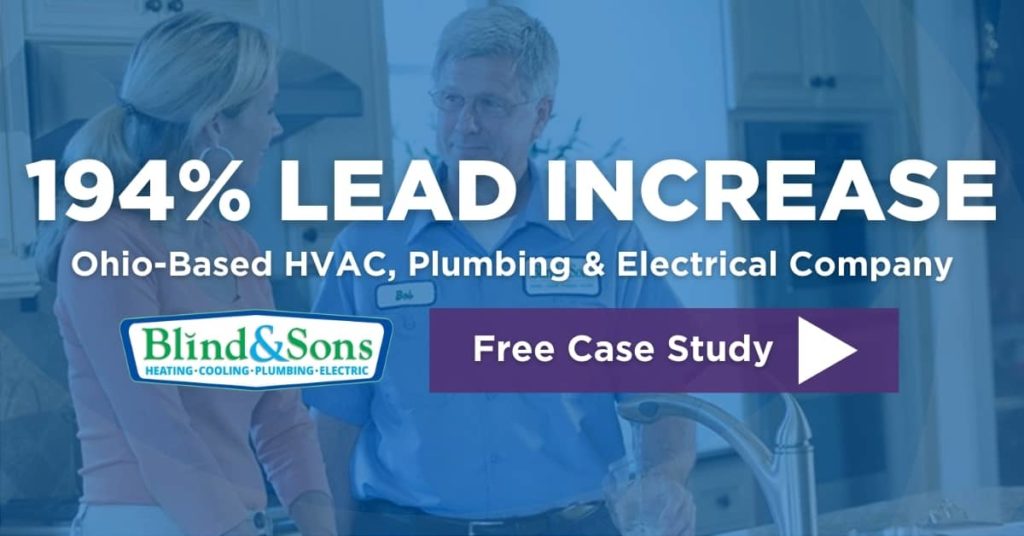

Recent Comments